Source: Dongxing Securities

DSP, or Digital Signal Processing technology, refers to chips capable of implementing digital signal processing technology. DSP chips are a type of fast and powerful microprocessor, uniquely capable of processing data in real-time. Internally, DSP chips use a Harvard architecture that separates program and data, featuring specialized hardware multipliers to quickly implement various digital signal processing algorithms. In today’s digital era, DSP has become a fundamental component in fields such as communications, computing, and consumer electronics.
The birth of DSP chips was a necessity of the times. Since the 1960s, with the rapid development of computers and information technology, digital signal processing technology emerged and developed quickly. Before the advent of DSP chips, digital signal processing could only be accomplished using microprocessors. However, due to the relatively slow processing speed of microprocessors, they could not meet the increasing demand for high-speed real-time processing of growing information volumes. Therefore, the need for faster and more efficient signal processing methods became increasingly urgent.
By the 1970s, the theoretical and algorithmic foundations of DSP chips had matured. However, at that time, DSP only existed in textbooks, and even the developed DSP systems were composed of discrete components, limited to military and aerospace applications.
In 1978, AMI released the world’s first single-chip DSP chip, the S2811, but it lacked the hardware multipliers necessary for modern DSP chips.
In 1979, the commercial programmable device 2920 released by Intel in the United States was a significant milestone for DSP chips, but it still did not have hardware multipliers.
In 1980, Japan’s NEC launched the MPD7720, the first commercial DSP chip with hardware multipliers, thus being regarded as the first single-chip DSP device.
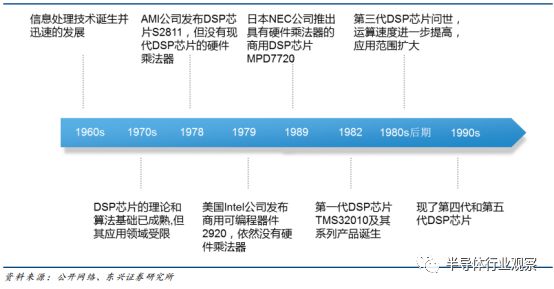
The birth process of DSP chips
In 1982, the first generation of DSP chips, TMS32010 and its series, was born. This DSP device was manufactured using micron technology NMOS, and although it had a larger power consumption and size, its computation speed was dozens of times faster than microprocessors. The emergence of DSP chips was a milestone, marking a significant step forward from large systems to miniaturized DSP application systems. By the mid-1980s, with the advent of CMOS technology, DSP chips saw a dramatic increase in storage capacity and computation speed, becoming foundational for speech processing and image hardware processing technologies.
In the late 1980s, the third generation of DSP chips emerged, with further improved computation speeds and gradually expanding application areas into telecommunications and computing.
In the 1990s, DSP development accelerated rapidly, leading to the emergence of the fourth and fifth generations of DSP chips. The fifth generation had a higher level of system integration compared to the fourth, integrating DSP cores and peripheral components into a single chip.
Entering the 21st century, the sixth generation of DSP chips emerged, significantly outperforming the fifth generation in terms of performance, while developing various personalized branches based on different commercial purposes, gradually expanding into new fields.
Application Fields of DSP Chips
DSP chips emphasize the real-time nature of digital signal processing. As digital signal processors, DSPs convert analog signals into digital signals for high-speed real-time processing by dedicated processors. They feature high speed, flexibility, programmability, and low power consumption, playing an increasingly important role in graphics and image processing, speech processing, and communications.
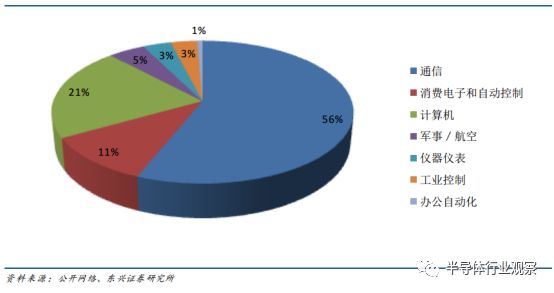
Application status of DSP chips in the market
The fields applying DSP are numerous, with new application areas expected to emerge continuously. According to statistics from authoritative information companies in the United States, the most common application of DSP chips in the market is in the telecommunications field, accounting for 56.1%; followed by computing, accounting for 21.16%; consumer electronics and automatic control accounting for 10.69%; military/aerospace accounting for 4.59%; instrumentation accounting for 3.5%; industrial control accounting for 3.31%; and office automation accounting for 0.65%.
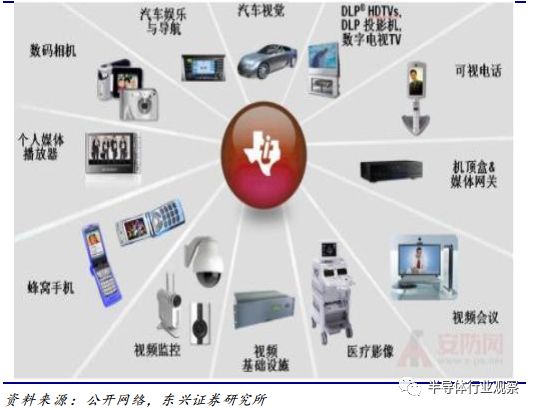
Application fields of DSP chips
1) Applications of DSP chips in multimedia communication.
The amount of information generated by media data transmission is enormous, and multimedia network terminals need to quickly analyze and process the information obtained throughout the process. Therefore, DSP is used in speech encoding, image compression, and reducing voice communication. Today, DSP provides real-time effects for speech decoding calculations, and the design protocols have become a basic international standard.
2) Applications of DSP chips in industrial control.
In the field of industrial control, industrial robots are widely used, and the performance requirements for robotic control systems are increasing. The key to robotic control systems is real-time performance; while completing an action, a large amount of data and computation processing is generated. Here, high-performance DSP can be utilized. By applying DSP to the robotic control system, the real-time calculation speed characteristic can be fully utilized, allowing the robotic system to quickly address issues. With the continuous improvement of DSP chip speeds, parallel processing networks can easily be constructed within systems, significantly enhancing control system performance, leading to broader development of robotic systems.
3) Applications of DSP chips in instrumentation.
The rich internal resources of DSP can greatly simplify the hardware circuitry of instruments, achieving SOC design for instrumentation. The measurement accuracy and speed of instruments are critical indicators; using DSP chips to develop products can significantly improve these two indicators. For example, TI’s TMS320F2810 features an efficient 32-bit CPU core, a 12-bit A/D converter, abundant on-chip memory, and a flexible command system, providing a broad platform for high-precision instruments. High-precision instruments have now become an important application of DSP and are in a period of rapid dissemination, driving technological innovation in the industry.
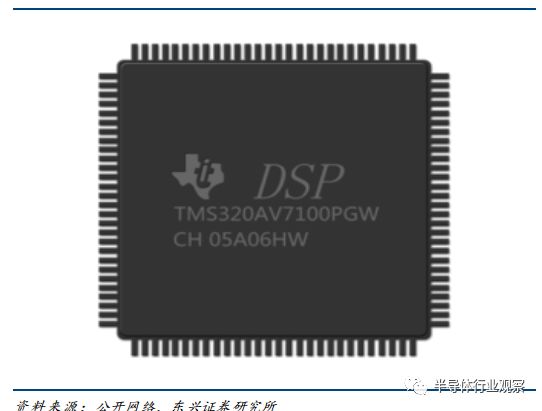
TMS320 chip from Texas Instruments
3) Applications of DSP chips in automotive safety and autonomous driving.
The automotive electronics system is increasingly flourishing, requiring DSP for analysis in systems such as infrared and millimeter-wave radar. Nowadays, as the number of cars increases, collision avoidance systems have become a research hotspot. Moreover, image data captured by cameras requires DSP processing to be displayed in driving systems for driver reference.
4) Applications of DSP chips in the military.
The low power consumption, small size, and real-time response speed of DSP are particularly needed in weaponry. For example, air-to-air missiles equipped with infrared detectors and corresponding DSP signal processors complete automatic target locking and tracking within a limited volume. Advanced fighter jets are equipped with visual targeting devices and soldiers carry helmet-mounted night vision devices, all requiring DSP technology for image filtering and enhancement, as well as intelligent target search and capture. DSP technology is also used in automatic artillery control, cruise missiles, early warning aircraft, and phased array antenna radar digital signal processing.
High-end Market Dominated by Foreign Companies
Currently, there are three major manufacturers of DSP chips in the world: Texas Instruments (TI), Analog Devices (ADI), and Motorola, with TI holding a dominant position, occupying the vast majority of the international market share, while ADI and Motorola also have a certain market presence.
Texas Instruments is recognized as the leader in the DSP industry, having successfully launched its first generation DSP chip TMS32010 in 1982. The TMS320 series DSP chips are characterized by their low cost, ease of use, and powerful functionality, making them the most influential and successful DSP series processors currently.
Among the three main series that TI focuses on, the C2000 series currently occupies a smaller market share, with TI’s DSP products mainly featuring the C6000 and C5000 series on its official website. TI’s three main DSP product series are: the C2000 series, primarily used for digital control systems; the C5000 (C54x, C55x) series, mainly for low-power, portable wireless communication terminal products; and the C6000 series, primarily for high-performance complex communication systems. The TMS320C54x series DSP chips in the C5000 series are widely used in telecommunications and personal consumer electronics.
The main products of the C6000 series include: C6000 DSP + ARM processors (12) — OMAP-L1x (5), 66AK2x (7); C6000 DSP (94) — C674xDSP (5), C66x DSP (11)
In the C5000 series, the flagship product is the C55x ultra-low power DSP, providing efficient signal processing for ultra-low power compact embedded products.
TI’s DSP products are primarily applied in machine vision, aerospace, defense, size, weight, and power (SWAP), audio, video encoding/decoding, and biometrics.

Flagship DSP chip products on TI’s official website
Currently, ADI has six flagship products, applied in fields such as speech processing, image processing, process control, measurement, and testing.
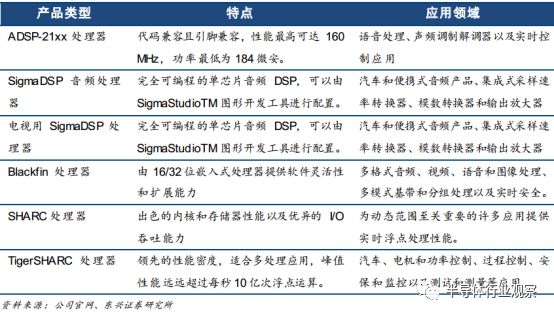
ADI’s flagship DSP products and application fields
Motorola is also one of the largest DSP chip manufacturers globally, with products including fixed-point and floating-point, dedicated and general-purpose, as well as 16-bit, 24-bit, and 32-bit DSP chips. DSP chips are mainly applied in speech processing, communications, digital cameras, multimedia, and control fields. Flagship products include the DSP56000 series, DSP56800 series, DSP56800E series, MSC8100 series, and DSP56300 series.
In the future, DSP technology will continue to develop and update in the following areas:
1) Increasing integration of DSP cores.
Reducing the size of DSP chips has always been a trend in DSP technology development. Currently, the most commonly used structure is based on RISC, and with the introduction of new process technologies, more manufacturers are beginning to improve DSP cores and integrate multiple DSP cores, MPU cores, and peripheral circuit units into a single chip, achieving system-level integration circuits for DSP.
2) Programmable DSP chips will be the dominant product in the future.
With the need for personalized development, the programmability of DSP provides manufacturers with more flexibility, allowing them to develop a wider range of product features on the same DSP chip, while also facilitating upgrades for users. For example, refrigerators and washing machines, which originally used microcontrollers, have now switched to programmable DSP for high-power motor control.
3) Fixed-point DSP occupies the mainstream.
Currently, among the DSP devices sold on the market, 16-bit fixed-point programmable DSP devices still dominate the mainstream products. As the cost of DSP fixed-point computing devices continues to decrease and their energy consumption advantages become increasingly apparent, fixed-point DSP chips will remain the main players in the market.
FPGA Chips and DSP Chips: A Complex Relationship
FPGA, or Field Programmable Gate Array, emerged as a semi-custom circuit in the field of Application-Specific Integrated Circuits (ASIC), addressing the shortcomings of custom circuits while overcoming the limitations of existing programmable devices with a limited number of logic gates. With FPGA chips, it is possible to program a newly invented CPU core and embed it into the FPGA chip, allowing for multiple cores to be embedded.

Basic architecture of FPGA
The international FPGA market is dominated by four giants: Xilinx, Altera, Microsemi, and Lattice. Altera and Xilinx are the inventors of FPGA, with Altera inventing the world’s first programmable logic device in 1983, and Xilinx launching the world’s first FPGA product, XC2064, in 1985. According to financial data from 2017, Xilinx had revenues of $2.349 billion, Altera (acquired by Intel) $1.902 billion, Microsemi’s FPGA business $421 million, and Lattice $386 million. Xilinx and Altera together dominate nearly 90% of the international market.

2017 FPGA market share of the four giants
FPGA chips and DSP chips have distinct differences. DSP is a specialized microprocessor suitable for conditional processes, especially for complex multi-algorithm tasks. FPGA contains a large number of resources for implementing combinational logic and can complete large-scale combinational logic circuit designs, as well as a significant number of flip-flops, which allow FPGA to perform complex sequential logic functions.
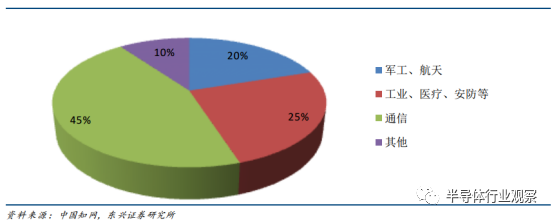
2016 FPGA chip application fields
FPGA chips and DSP chips have distinct differences. DSP is a specialized microprocessor suitable for conditional processes, especially for complex multi-algorithm tasks. FPGA contains a large number of resources for implementing combinational logic and can complete large-scale combinational logic circuit designs, as well as a significant number of flip-flops, which allow FPGA to perform complex sequential logic functions.
• DSP chips have relatively weak generality, while FPGA has stronger versatility;
• DSP offers software flexibility, whereas FPGA offers hardware speed;
• DSP processes lower-speed event series execution but may have some latency before processing, while FPGA cannot process multiple events simultaneously as each event has dedicated hardware, but this specialized hardware allows each event to execute concurrently;
• DSP is programmed in a sequential instruction flow, while FPGA is programmed in a block diagram format, making data flow easy to visualize.
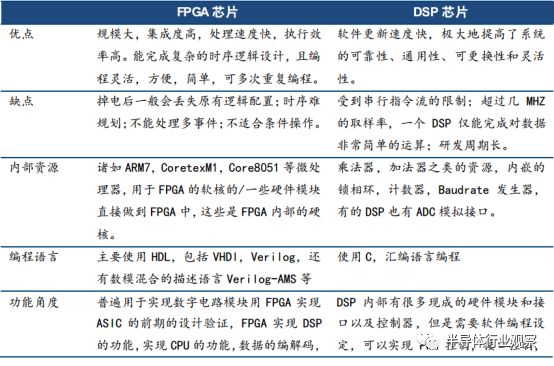

Comparison between FPGA chips and DSP chips
Under the emphasis on structural flexibility, versatility, and the need for processing complex algorithms, DSP and FPGA are often combined, adopting a DSP + FPGA structure, or embedding DSP modules within FPGA chips. This is also a trend in future designs.
Farewell to the Pain of Lack of Chips, Breakthroughs in Domestic DSP
The “Core High Base” major project has been vigorously promoting the research and development of domestic high-end chips at the national level. In 2006, the State Council issued the “National Medium and Long-term Science and Technology Development Plan Outline (2006-2020)”, listing “core electronic devices, high-end general-purpose chips, and basic software products” (referred to as the “Core High Base Major Project”) as the first of 16 major scientific and technological projects, also known as the “01 Project”.
The implementation of this project has greatly accelerated the development speed of China’s integrated circuit industry. Between 2001 and 2016, China’s integrated circuit market size increased from 126 billion yuan to approximately 1.2 trillion yuan, accounting for nearly 60% of the global market share, with industry sales expanding over 23 times from 18.8 billion yuan to 433.6 billion yuan. Research on DSP in China started relatively late but has developed rapidly. The 14th Institute of Electronics has undertaken the task of developing DSP chips.
After 10 years of hard work, the 14th Institute, in collaboration with Longxin Technology and Tsinghua University, developed the domestic DSP chip Huairui No. 1, which passed the acceptance of the Core High Base Special Group in 2012. Huairui No. 1 has been successfully applied in over 10 types of radar products from the 14th Institute, creating three records for domestic multi-core DSP chip products: the most application models in radar equipment, the highest number of applications per unit, and the total number of applications.
Currently, Huairui No. 2 has been successfully developed, passed internal testing, and will soon be launched in the market. The next step for the 14th Institute is to adopt more advanced manufacturing processes in Huairui No. 3, further increasing the main frequency, enhancing general performance, and improving specialized performance through stream processing methods while reducing power consumption.
“Huairui No. 1” represents the highest level of domestic DSP chip technology. In system design, it employs a multi-core architecture design technology integrating DSP and CPU. Test results show that “Huairui No. 1” has significant advantages in processing capacity and energy consumption, and runs a multitasking real-time operating system very stably, with overall technical indicators reaching or exceeding the level of similar international products. Huairui No. 1 fills the gap in China’s multi-core DSP field, significantly enhancing the country’s independent research and development capabilities for high-end chips, improving the level of electronic equipment manufacturing, and ensuring national information security.
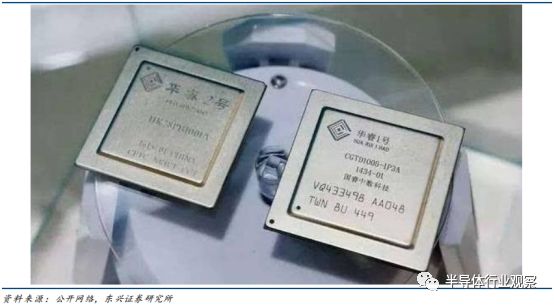
Huairui chip
Huanxin No. 1 was developed by the 38th Institute of China Electronics Corporation, with testing completed in 2012. Huanxin No. 1 (BWDSP100) is a 32-bit static superscalar processor, belonging to the second development stage of DSP products. This chip is based on 55nm manufacturing technology, achieving complete independent intellectual property rights.
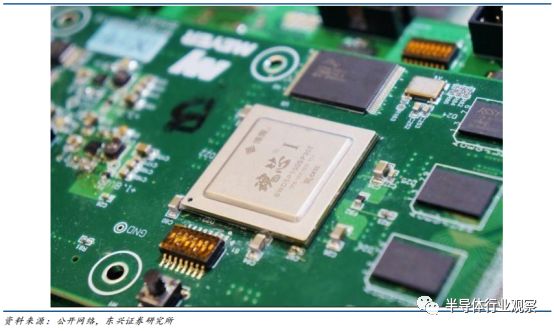
Huanxin No. 1
Huanxin No. 1 has reached the level of mainstream international DSP chips, with performance comparable to ADI’s TS201 chip. TS201 is a mainstream DSP chip from ADI, integrating both fixed-point and floating-point computing functions. This processor is widely used in video, communications markets, and defense military equipment, suitable for applications requiring large data volume real-time processing.
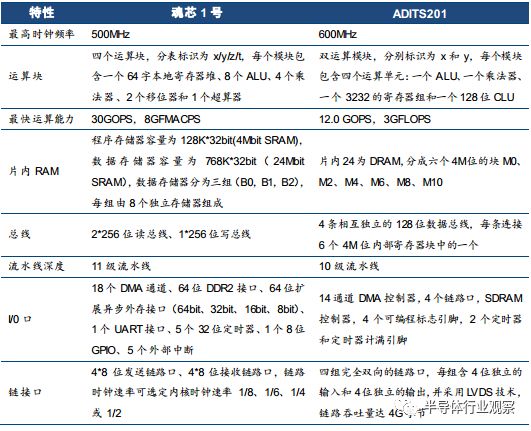

Comparison of Huanxin No. 1 and TS201 characteristics
Huanxin No. 1 is a high-performance general-purpose DSP that can be widely applied in various high-performance signal processing fields. Typical equipment applications include radar, sonar, and electronic countermeasures.
Huanxin No. 2 A has just been released, with single-core performance exceeding that of current international similar chip performance by 4 times. On April 23, 2018, the 38th Institute of China Electronics Corporation released Huanxin No. 2 A, which adopts a fully independent system architecture, developed over six years. Compared to Huanxin No. 1, Huanxin No. 2 A’s performance has improved sixfold, transforming from single-core to multi-core, expanding computational components, and upgrading the instruction system, allowing the device to achieve a trillion floating-point operations simultaneously, with a relatively good application environment and debugging methods; a single core can achieve 1024 floating-point FFT (Fast Fourier Transform) operations in just 1.6 microseconds, with computational efficiency 3 times higher than Texas Instruments’ TMS320C6678, and actual performance 1.7 times higher, with a device data throughput rate reaching 240Gb per second.
Massive Market Potential for DSP Chips in Civil Information Fields
DSP chips support the digital integration of communications, computing, and consumer electronics. In the wireless field, DSP is prevalent in wireless switching devices, base stations, and handheld terminals; in the network field, DSP encompasses everything from infrastructure to broadband access devices, including IP gateways, IP phones, and cable modems. As the demand for digital consumer products in China has surged, along with improvements in DSP’s high-speed computation and synchronous processing capabilities, the application areas of DSP are gradually expanding from mobile phone domains to new types of digital consumer fields, thus spanning the 3C sectors with increasingly balanced distribution.
DSP chips play an important role in smartphones. DSP chips can enhance voice, audio, and image experiences for mobile phones, significantly improving the capability of single functions and speeding up phone operations. Due to the powerful computational capabilities of DSP, cellular phones for mobile communication have rapidly risen, creating a series of fully digital cellular networks such as GSM and CDMA. Moreover, DSP chips are crucial determinants for the upgrade of electronic products like mobile phones. According to the Ministry of Industry and Information Technology, in 2017, the net increase in mobile phone users was 95.55 million, bringing the total to 1.42 billion, with a mobile phone penetration rate of 102.5 units per hundred people, an increase of 6.9 units per hundred people compared to the previous year. The steady rise in mobile phone demand will lead to a significant demand for integrated circuits such as DSP chips.
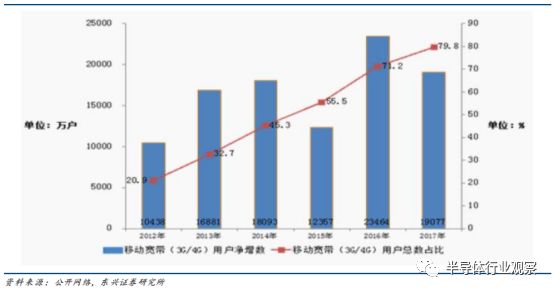
Development of fixed-line and mobile phone users from 2000 to 2017
The demand for mobile broadband and DSP is positively correlated. ADSL and HFC, the two most common broadband access technologies based on DSP, along with DSP-based general systems, can realize wireless access point communication systems with good openness, flexible configuration, and strong scalability. Therefore, the demand for mobile broadband and DSP is positively correlated. By the end of 2017, the total number of fixed internet broadband access users among the three basic telecommunications companies reached 349 million, with a net increase of 51.33 million for the year. The total number of mobile broadband users (i.e., 3G and 4G users) reached 1.13 billion, with a net increase of 191 million for the year, accounting for 79.8% of mobile phone users. As mobile broadband becomes more popular, future demand for the DSP market is promising.
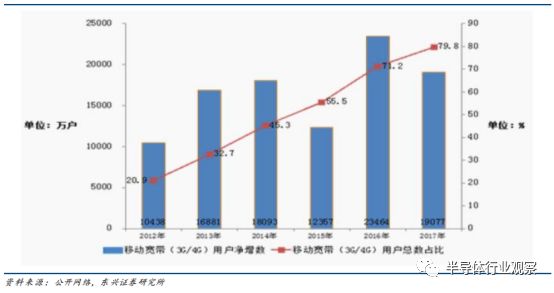
Development of mobile broadband users from 2000 to 2017, including 3G and 4G
The demand for digital consumer products such as IPTV is expanding, and the future market demand for DSP chips in new digital consumer fields is promising. The DSP + FPGA gateway implementation solution can convert digital television signals into multicast signals, integrating cable television services with telephone voice services and internet services. In recent years, the government has vigorously introduced supportive policies to accelerate the cultivation of emerging businesses such as IPTV, the Internet of Things, and smart homes. By the end of 2017, the number of IPTV users reached 122 million, with a net increase of 35.45 million for the year.